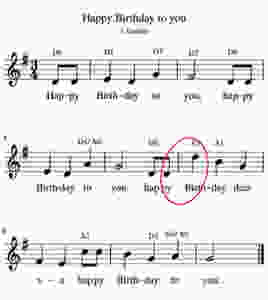In the past week of teaching, I’ve noticed a problem among most students learning new pieces or songs. All seem to have pauses or hesitations throughout their music–even if from memory–in transitional places. You know what I’m talking about. You hear someone play a song and things are going well, but when a different section happens, or a large jump, anything different, they stop to see where to go next. These dreaded pauses cause listeners to wait in anticipation for what’s next. This can easily be avoided with the right practice strategy!
What exactly am I talking about?
If you’re still unsure about what exactly I’m talking about, let’s use the song “Happy Birthday” as an example. We will use this example throughout the rest of the article. Imagine you’re playing, (or hearing), this tune, and it goes something like this:
“Happy Birthday to you,Happy Birthday to you,Happy —- *long pause* —- BIRTHDAY dear Charlie, Happy Birthday to you! “’
Here is a photo of the score. (I’ve circled where the pause has occurred to clarify.)

Why Does This Happen?
Why the pause there? That is the climax! But of course that’s where an error would be; it has the largest jump out of anywhere in the entire song, (a full octave)! There are two reasons for the hesitation on this jump: a mental block and a physical block.
Number 1: Players know that it’s coming and don’t want to miss such a large leap, so they overcompensate by pausing and really focus on getting it right, (i.e. “sticking the landing”). This would be a mental block.
Number 2: Players know what it’s supposed to sound like, they aren’t afraid, but rather they can’t get to the octave quick enough. This would be a physical block.
Now that we know why this problem has occurred, let’s talk about how to fix it.
How To Fix It
Whenever there’s a large jump or a certain shift in the music that has caused delay, the first thing to do is to identify the problem. Identify the problem exactly, (this will usually be two notes, or two beats). Just as we did in “Happy Birthday,” identify which two notes are causing the delay–NOT the area in general, but the EXACT two notes. In “Happy Birthday” it was the octave. Circle those two notes. In the “Happy Birthday” example, we would circle the notes on that octave, or “py birth.”
Now that we’ve identified the exact problem, we need to isolate it in practice. The brain absorbs information better in small chunks. Slowly play those two notes over and over again until it feels comfortable. Gradually close the gap of time between them. For the “Happy Birthday” example. You would play “py birth” repeatedly. That octave should become easy and even at a slow tempo.
After the octave becomes easy and even in a slow tempo, try speeding it up. (Yes, just those two notes!). Play them faster and faster–even faster than the actual performance tempo. “Py- birth-py-birth-py-birth-py-birth!”
Once comfortable with the two problem notes, add the two notes around it. Add just one note on either side of the two note problem area and play the four notes at a slow tempo. In “Happy Birthday,” we would now play “hap- py- birth- day-”. Use the same steps as before: play slowly until perfectly in time and comfortable, and then speed it up gradually.
Now that those four notes are perfect, add more surrounding text. In “Happy Birthday,” we would play “Birthday, Happy Birthday, Happy.” Apply the same steps as before: slow it down and gradually speed it up.
Finally, play the entire thing at tempo. Is it easier? It should be! If it’s still not quite up to par, go back to the original problem area (“py-birth”), and regroup. Keep practicing small chunks until it starts to come together–I promise it will work!
Now that you can play the whole song, or whole section, perfectly, go practice something else for a while and come back to it. That’s a good test for your motor memory. Switching focus often let’s us constantly reevaluate. Practicing this way creates a way to check real progress. And again, if it’s not as good as it was before, go back to the original two notes and repeat the process again! Do these steps and your transition problems will be solved!
Prevention
To prevent transition hesitations and pauses in future songs or pieces, I have two pieces of advice:
- Before you start learning something, look through it and identify potential problem areas. Circle them and practice them first each time you start practicing the piece.
- NEVER keep playing after you pause at a place like this. Stop and isolate the problem. Fix it, (or take steps to fixing it), before going on. If you allow the pause to become part of your playing, it is even harder to fix later! It will take more time. Address it immediately and don’t procrastinate!
That’s a lot of talk about two notes! But most often the biggest problems of playing come from small errors! So remember to slow down and isolate in practice!






